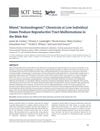Anogenital Distance as a Biomarker for Incomplete Masculinization: Molecular Mechanisms in the Perineum
January 2020
in “
Research Portal Denmark
”

TLDR A short male anogenital distance may indicate incomplete masculinization due to disrupted androgen action.
The study explored the role of androgen signaling in the development of the anogenital distance (AGD) as a biomarker for incomplete masculinization, focusing on the molecular mechanisms in the perineum. It found that a short male AGD, linked to disrupted fetal androgen action, was associated with a feminized transcriptional profile in perineal tissues. The research identified Wnt and estrogen signaling pathways as potential contributors to perineal development, with anti-androgenic chemicals like finasteride and enzalutamide affecting these pathways. The study suggested that differences in progenitor cell populations might underlie the sex-specific development of perineal muscles, providing new targets for future research on chemically induced effects on AGD.



